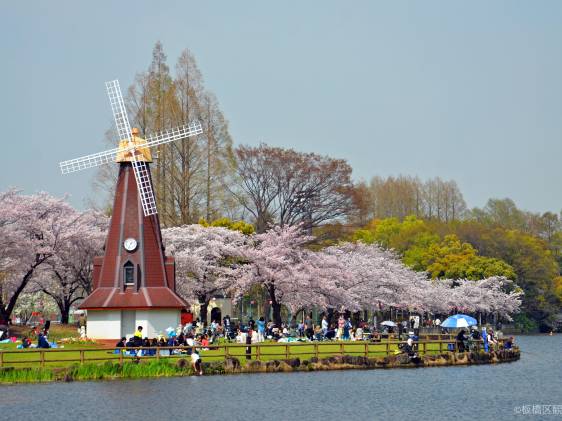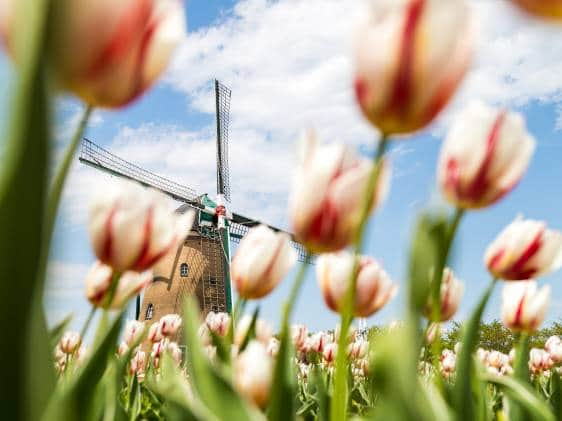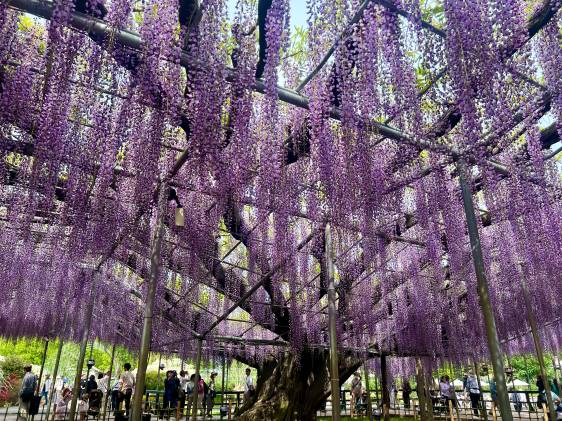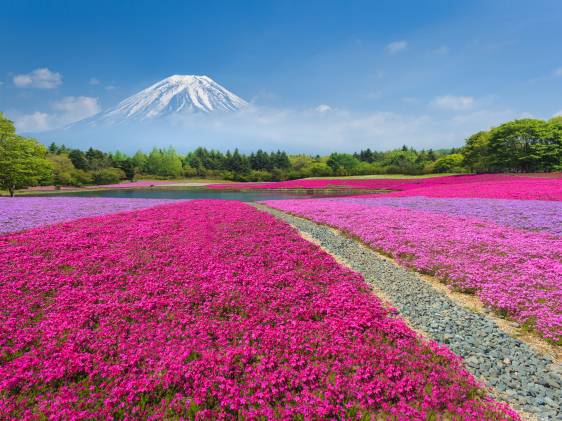While the cherry blossom may be Japan’s most famous spring flower, it is by no means the only one. In fact, you might find that you prefer the drapey purple plumes of fuji-no-hana (wisteria), or the bold pink shibazakura (moss phlox) that covers whole fields around Mt. Fuji (and elsewhere).
Where there are flowers, there are festivals. Some of the Tokyo flower festivals, like those held at shrines, have long traditions. Others are more contemporary and may include flowers not always associated with Japan (like tulips). Many have evening illuminations — for you to start taking advantage of the warmer weather.
1. Tulips
AprilUkima Park (Tokyo), Showa Memorial Park (Tokyo), and Sakura City (Chiba Prefecture)
Tulips are not traditionally associated with Japan, but they’re still bloomin’ marvellous. Get your tulip fix at any of these three parks.

Ukima Park
Itabashi20 minutes by train from Shinjuku
Ukima Park is a hidden gem in Tokyo’s northern suburbs. There are 20,000 or so tulips here, which are illuminated in the evening during the park’s spring festival. The park also has a windmill, for extra Holland vibes.
Shōwa Memorial Park
Tachikawa30 minutes by train from Shinjuku
Shōwa Memorial Park is a huge park in suburban west Tokyo. Its annual spring flower festival runs from late March all the way through late May, covering the whole season — from cherry blossoms to red poppies. The highlight, however, is considered to be the tulips, which bloom in April.
| At the door: ¥450 | ||
Sakura Tulip Festa
Sakura, Chiba Prefecture1 hour by train from Ueno + bus or 40-minute walk
If you really want to see A LOT of tulips and are willing to travel outside of Tokyo then the Sakura Tulip Festival — the largest in the Kantō area — is for you. There are lots of food stalls and trucks, and even a tulip market among the festivities.
If you arrive early, you might be able to grab one of the rental bicycles available at Sakura Station — the best way to travel between the station and the park.
2. Azaleas
AprilNezu Shrine (Tokyo)

Azaleas — tsutsuji in Japanese — are bright and beautiful, especially when they fill the grounds of a shrine in central Tokyo. Nezu Shrine holds its annual flower festival in its 300-year-old azalea garden, which is home to over 3000 plants representing some 100 different species.
During the festival, there are antique fairs, plant fairs, and more — it’s a whole thing, with a traditional atmosphere.
| At the door: ¥500 | ||
3. Nemophila (baby blue eyes)
Mid-April to early MayHitachi Seaside Park (Ibaraki Prefecture)
1 hour and 15 minutes by Ltd. Express train from Ueno + 15 minute shuttle bus, or an easy bus tour

Come spring, the Miharashi Hills of Hitachi Seaside Park transform into fields of blue. It’s part of the park’s annual spring celebration, aptly called Flowering, which includes other blooms, too. The nemophila usually peak between mid-April and early May.
As the park can be a little difficult to get to on your own, it’s worth going on a one-day tour that visits both Hitachi Seaside Park and Ashikaga Flower Park. Tickets start from ¥12,900.
4. Wisteria
Mid-April to mid-MayKameido Tenjin (Tokyo) and Ashikaga Flower Park (Tochigi Prefecture)

The timing can prove tricky for wisteria in Tokyo, but it’s so worth it if you can catch them in full bloom.
Kameido Tenjin
Kameido, Tokyo15-minute walk from Kameido Station in Tokyo
The best place in Tokyo to see these hanging blossoms is Kameido Tenjin, a 17th-century Shintō shrine in Kameido, a neighborhood on Tokyo’s east side. The shrine has a pond, which reflects the wisteria beautifully, and an arched bridge known as a “drum bridge,” making it a scenic spot. The annual wisteria festival has evening illuminations and often some cultural events.
Ashikaga Flower Park
Ashikaga, Tochigi Prefecture1 hour and 20 minutes from Tokyo Station
If you don’t mind going a little farther, Ashikaga Flower Park in Tochigi Prefecture is an even bigger destination for wisteria. Not only do they have the usual light purple wisteria, but they also have ones in the same shade as cherry blossoms, as well as white, yellow, and green ones.
During the park’s Great Wisteria Festival, there are evening illuminations and the park’s opening hours are extended (except for the first week).
Pro tip: Combine a trip to see the nemophila at Hitachi Seaside Park AND the wisteria at Ashikaga Flower Park with this one-day tour that visits both.
5. Shibazakura (moss phlox)
Mid-April to late-MayFuji Five Lakes (Yamanashi Prefecture) and Chichibu (Saitama Prefecture)

Mt. Fuji Shibazakura Festival
Lake Motosuko, Fuji Five LakesAbout 3 hours from Shinjuku by train and bus
Pink, white, magenta, and light purple flowers carpet the ground at Fuji Motosuko Resort during the annual Mt. Fuji Shibazakura Festival. In total, there are around 800,000 flowers.
Going by ordinary public transport, you’ll first need to get from Tokyo to Kawaguchiko, the biggest hub in the Fuji Five Lakes region. From Kawaguchiko Station, there is a shuttle service called Shiba-Sakura, running to the festival grounds (¥2,750 round-trip, including entrance ticket; 30-40 minutes).
Also, if you’re keen to see more of Fuji Five Lakes, but don’t want to sort out the transport, this one-day tour from Tokyo packs in a lot, including: strawberry picking, entry to the Fuji Shibazakura Festival, and a ride up to the Saiko Iyashi no Sato traditional village.
Chichibu Shibazakura Festival
Chichibu, Saitama Prefecture80 minutes by train from Ikebukuro Station + 20-minute walk
If Mt. Fuji is too far, consider visiting Chichibu for its shibazakura instead. Specifically, the place to check out is Hitsujiyama Park’s Shibazakura Hill, which has about 400,000 shibazakura flowers. Note the earlier end date for this festival.
If you’re looking for something extra special, Seibu Railways runs a late-afternoon train service between Chichibu and Tokyo (Ikebukuro Station) with designer dining cars and gourmet meals.
| At the door: ¥300 | ||
6. Roses
MayKyū-Furukawa Teien (Tokyo)

Kyū-Furukawa Teien, near Komagome Station, is famous for its vibrant roses, which bloom in mid-May. Its rose garden is kind of shaped like a maze, which makes for good photos with the Western-style residence in the background.
| At the door: ¥150 | ||
| At the door: ¥70 | ||
Want more ideas that require even less planning? Check out these easy spring bus tours from Tokyo.
This article on Tokyo flower festivals is updated annually. Blooming times are dependent on the weather, and so may vary from the forecasts. Other information is also subject to change. Post first published in April 2015. Last updated in March 2025 by Alex Ziminski.
Get our Tokyo Cheapo Hacks direct to your inbox
-
 Tokyo’s Best Apartment-Style Hotels, by Area
Tokyo’s Best Apartment-Style Hotels, by Area -
 Highway to Hot Springs: Tokyo to Kusatsu Onsen by Bus
Highway to Hot Springs: Tokyo to Kusatsu Onsen by Bus -
 The Best Pocket Wi-Fi for Visiting Japan — Compared
The Best Pocket Wi-Fi for Visiting Japan — Compared -
 Go-Karting in Tokyo: Everything You Need To Know
Go-Karting in Tokyo: Everything You Need To Know -
 Morning Sumo Practice in Tokyo—Everything You Need To Know
Morning Sumo Practice in Tokyo—Everything You Need To Know -
 First-Time Harajuku Itinerary: Fashion, Street Food, and More
First-Time Harajuku Itinerary: Fashion, Street Food, and More
Recommended hotels located nearby
-
Sugamo 1.5 km
-
Jūjō 2.8 km
-
-
Sendagi 2.3 km


































